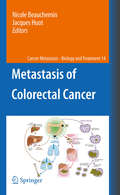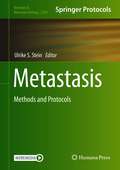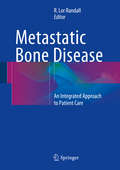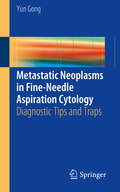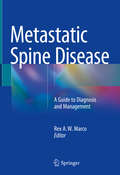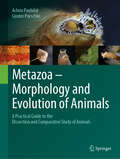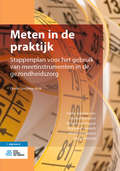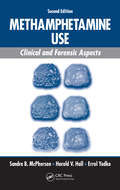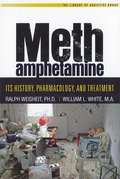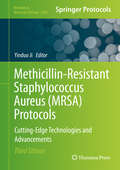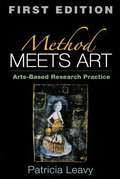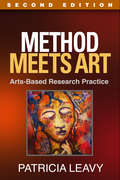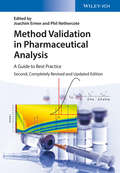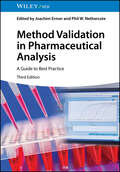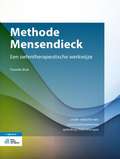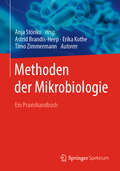- Table View
- List View
Metastasis Research Protocols: Analysis of Cells and Tissues
by Udo Schumacher Susan A. BrooksMetastasis Research Protocols describes in detail all the methods needed to investigate why and how metastasis occurs. Volume I presents a comprehensive collection of established and leading-edge techniques for analyzing the expression of key molecules and for examining their production at the genetic level. The work focuses on the analysis and mapping of molecules produced by cells and tissues, and on the molecular biology underlying their expression. The traditional methods range from the histopathological and the immunocytochemical to SDS-PAGE, Western blotting, and enzyme zymography. Newer and more specialized techniques for analyzing the genetic aspects of metastasis include in situ hybridization to localize mRNAs, FISH, CGH, methylation analysis of CpG islands, RT-PCR, and differential display. Volume II presents a comprehensive collection of established and leading-edge techniques for examining metastatic behavior in vitro and whole animal models. Methods are provided for the separation of cell lines with high and low metastatic potential, along with assay systems to test defined aspects of the metastatic cascade. These systems include cell migration assays, assays for matrix degrading enzymes, basement membrane degrading assays, adhesion assays, and assays of angiogenesis. The detailed descriptions of animal models of metastasis cover the use of immunodeficient animals, syngenic and transgenic models, and orthotopic models of metastasis.
Metastasis of Colorectal Cancer
by Jacques Huot Nicole BeaucheminColorectal cancer is the third most common cancer worldwide, and in many parts of the western world, it is the second leading cause of cancer-related deaths. This book covers colon cancer metastasis from the most fundamental aspects to clinical practice. Major topics include physiopathology, genetic and epigenetic controls, cancer initiating cells, epithelial-mesenchymal transition, growth factors and signalling, cell adhesion, natures of liver metastasis, angiogenesis and lymphangiogenesis, inflammatory response, prognostic markers, sentinel node and staging, and finally diagnosis and treatment. Each chapter has been contributed by leaders in the field. A key feature is that it connects with a large readership including students, fundamentalists and clinicians. Another specific feature of the book is that the chapters are written in a didactic and illustrative fashion. These characteristics coupled with the choice of the topics and authors, makes this book a reference in the field. It represents an essential acquisition for medical libraries, clinicians as well as medical and graduate students.
Metastasis: Methods and Protocols (Methods in Molecular Biology #2294)
by Ulrike S. SteinThis volume provides the most recent developments and methodologies on metastatic process, formation, and detection. Chapters guide readers through functional metastasis in vitro assays, non-mouse and mice metastasis models, methods for imaging metastasis, analyzing the tumor microenvironment, senescence and inflammation with respect to metastasis, methods to investgate the premetastatic/ metastatic, detecting biomarkers in patient, and bioinformatics to simulate the metastatic process. Written in the highly successful Methods in Molecular Biology series format, chapters include introductions to their respective topics, lists of the necessary materials and reagents, step-by-step, readily reproducible laboratory protocols, and tips on troubleshooting and avoiding known pitfalls. Authoritative and cutting-edge, Metastasis: Methods and Protocols aims to be a useful practical guide to researches to help further their study in this field.
Metastatic Bone Disease
by R. Lor RandallProviding an integrated approach to the diagnosis and management of patients with metastatic bone disease (MBD), this comprehensive text combines discussion of the pathobiology of the disease with the latest oncological and orthopedic treatment modalities. After opening with an examination of the epidemiology and impact of MBD, the biology of bone metastases are discussed, along with considerations of the tissue of origin. Evaluation, biopsy and medical therapy, including metabolic agents and bio targeting. The heart of the book presents oncological approaches (supportive, radiation and interventional) and principles of orthopedic surgical oncology, with subsequent chapters covering specific anatomy, from the pelvis to the lower extremity and the spine. Chapters on emerging surgical technology and future directions conclude the text and redefine an integrated approach to patient care. Taken together, Metastatic Bone Disease is an excellent resource for orthopedic surgeons and cancer specialists alike.
Metastatic Bone Disease: An Integrated Approach to Patient Care
by R. Lor RandallSkeletally related events make up approximately 20% of the cancer care economy. Advances in understanding the pathobiology and better biotargeted therapy and improved surgical technology are occurring continuously. Hundreds of thousands of patients are living longer with ever-increasing tumor burden, but patients can remain siloed in their care as they navigate across subspecialty treatments. This comprehensive text ties it all together around the patient, integrating all aspects of care.Providing an integrated approach to the diagnosis and management of patients with metastatic bone disease (MBD), this revised and expanded text combines discussion of the pathobiology of the disease with the latest oncological and orthopedic treatment modalities. After opening with an examination of the epidemiology and impact of MBD, the biology of bone metastases are discussed, along with considerations of the tissue of origin, evaluation, biopsy andmedical therapy, including metabolic agents and biotargeting. The heart of the book presents oncological approaches (supportive, radiation and interventional) and principles of orthopedic surgical oncology, with subsequent chapters covering specific anatomy, from the pelvis to the lower extremity and the spine. Chapters on emerging surgical technology and future directions conclude the text. New to this edition are considerations around patient-reported outcomes. Utilizing the latest clinical evidence and treatment techniques, Metastatic Bone Disease, Second Edition is standalone resource reflecting a comprehensive, patient-centric resource for all types of providers.
Metastatic Neoplasms in Fine-Needle Aspiration Cytology
by Yun GongThis book focuses primarily on the most efficient way to make an accurate FNA diagnosis of metastatic tumors within the broad confines of cytopathology. The text provides a step-by-step "thought process" during the diagnostic approach of the metastatic tumors using detailed algorithms. Starting from the onsite immediate FNA sample assessment, the book provides strategy of specimen triage to facilitate further cytology evaluation based on the metastatic patterns and morphologic patterns of the tumors. In the subsequent chapter, the book provides tips and traps of selecting markers and interpretation of immunoperoxidase, flow cytometric, cytogenetic and molecular studies. The book includes the strategy of dealing with limited FNA material and wisely use existing samples (cell block, direct smear, cytospin) for different ancillary studies including molecular tests that have been used at MD Anderson. The author highlights challenging issues to show the importance of using a multidisciplinary (clinical, radiologic, cytologic and ancillary studies) approach. Extensive illustrations are provided. Metastatic Neoplasms in Fine-Needle Aspiration Cytology will provide pathology residents, fellows, practicing cytopathologists and cytotechnologists with a practical way to approach metastatic malignancies in daily cytology practice as well as provide a vision of the future of cytopathology.
Metastatic Spine Disease: A Guide To Diagnosis And Management
by Rex A. W. MarcoThis comprehensive text focuses exclusively on the management of metastatic spinal disease, evaluating the most recent literature and providing patient-centered treatment algorithms. Beginning with initial imaging, classification and clinical decision-making, the spine is approached anatomically from the upper cervical to the sacrum, describing the unique considerations and approaches appropriate to each region, such as laminectomy and stabilization, en bloc spondylectomy and resection and reconstruction. Less invasive and minimally invasive approaches are discussed throughout the text. Radiation therapy modalities and other adjuvant treatments are also discussed, as well as reconstructive flap coverage and the management of complications. The spinal column is the most common site of metastatic cancer, and a multidisciplinary approach is required to provide patients with reasonable management options to prevent and treat the disabling symptoms caused by this debilitating condition. This compendium of experience from thought leaders in the treatment of metastatic spine disease will provide spine surgeons, oncologists, radiation oncologists, physiatrists and palliative care specialists with up-to-date information to guide their patients through the multidisciplinary management of metastatic spinal disease.
Metazoa – Morphology and Evolution of Animals: A Practical Guide to the Dissection and Comparative Study of Animals
by Günter Purschke Achim PaululatOver the course of evolution, multicellular animals - Metazoa - have successfully colonized every conceivable habitat on our planet, thanks to their ability to survive and adapt under adverse or changing conditions. But how is an animal's body structured to accomplish this? What organs do animals have, how do they perceive their environment, and what is the evolutionary relationship between these seemingly so different organisms? This volume, designed as a modern practical book, presents the most important body plans of selected animals. It is intended to help all Biology students to recognize and understand the basic body shapes and structures in the respective animal groups, including the main features that have contributed to their evolutionary success, the similarities and differences, and the many different solutions that evolution has come up with for given biological problems. The authors have consistently used focused, compact text and photographs that not only show the animals' most important external features but also explain the dissection process step by step. The authors hope that this new book will help all Biology students successfully complete their practical zoology course and gain new insights into the morphology and evolution of animals.
Meten in de praktijk: Stappenplan voor het gebruik van meetinstrumenten in de gezondheidszorg
by Hester Vermeulen Harriët Wittink Sandra Beurskens Raymond Swinkels Roland Van PeppenHet doel van dit boek is om je aan de hand van een stappenplan te leren op een systematische en kritische manier het juiste meetinstrument te zoeken, te selecteren en de uitkomsten te interpreteren en integreren in het behandelproces. Het uitgangspunt is dat meten geen doel op zich is maar dat het meten processen ondersteunt. Als dat niet het geval is, is het gebruik van meetinstrumenten tijdsverspilling voor zorgprofessionals én patiënten en moet je het niet doen. In de dagelijkse zorg hebben zorgprofessionals veel vragen. Wat wil een patiënt bereiken? Waar gaan we aan werken? Wat zijn de effecten van de zorg? Moet de behandeling worden bijgesteld? Door meten worden deze zaken verhelderd en geobjectiveerd. De zorgprofessional en patiënt hebben hier profijt van, zowel bij het bepalen van de diagnose, het voorspellen van het beloop van het herstel, het samen bepalen van het doel en het evalueren van een behandeling. Meten in de praktijk - Stappenplan voor het gebruik van meetinstrumenten in de gezondheidszorg is onmisbaar voor zorgprofessionals, studenten en docenten aan gezondheidszorgopleidingen in het hoger onderwijs. Daarnaast is het een handige gids voor professionals en kwaliteitsmedewerkers die werkzaam zijn in de gezondheidszorg. In deze derde druk zijn twee hoofdstukken toegevoegd waarbij het accent ligt op het interpreteren en gebruiken van de resultaten in het zorgproces. Verder wordt samengewerkt met de website www.meetinstrumentenzorg.nl waardoor de meetinstrumenten en de gebruikersinformatie vrij toegankelijk beschikbaar zijn. Aansluitend op de patiëntgerichte benadering, ligt het accent in het boek op de zogenaamde 'patiënt reported outcomes' (PRO's). Meten in de praktijk is een prachtig hulpmiddel bij zinvol inzetten van meetinstrumenten waarbij de zorgprofessional en de patiënt gezamenlijk het doel en verloop van de behandeling bespreken en bepalen en deze na afloop evalueren. De focus in dit boek ligt meer op ‘Weten waarom en wat je wilt meten’ dan op het bekende ‘Meten is weten’.
Methamphetamine Addiction
by John Roll Richard RawsonSeparating myth from fact, this authoritative work reviews the breadth of current knowledge about methamphetamine addiction and describes the most promising available treatment approaches. Leading experts present state-of-the-art information on the effects of methamphetamine on the brain, body, mental health, and behavior. Psychosocial and pharmacological treatment strategies are critically evaluated, including approaches to treating dually diagnosed clients. Written in a concise, accessible style, the volume emphasizes that recovery is possible, despite the significant challenges the drug poses. The authors identify key avenues for collaboration among clinical, public health, and other professionals.
Methamphetamine Use: Clinical and Forensic Aspects, Second Edition
by Sandra B. McPherson Harold V. Hall Errol YudkoUpdated and expanded to reflect changes in recent years, this second edition covers virtually every aspect of this dangerous drug, including history, pharmacology, pathology, physiology, treatment, clinical and forensic psychology, and legal aspects. This edition features new chapters on criminal- and civil-forensic applications including an in-depth discussion of recent laws. Pointing out important cases, articles, and statistics, the text also presents chapters on neuropsychological testing; normative data on risk analysis and violence prediction; the physiology of tweaking, the most dangerous stage of the meth cycle; and the efficacy of treatment programs including examples from newly established drug courts.
Methamphetamine: Its History, Pharmacology and Treatment
by Whilliam L. White Ralph WeisheitThe definitive book on the impact of methamphetamine on individuals, communities, and society by two of America's leading addiction and criminal justice experts.In recent years, the media have inundated us with coverage of the horrors that befall methamphetamine users, and the fires, explosions, and toxic waste created by meth labs that threaten the well-being of innocent people. In Methamphetamine: Its History, Pharmacology, and Treatment, the first book in Hazelden's Library of Addictive Drugs series, Ralph Weisheit and William L. White examine the nature and extent of meth use in the United States, from meth's early reputation as a "wonder drug" to the current perception that it is a "scourge" of society.In separating fact from fiction, Weisheit and White provide context for understanding the meth problem by tracing its history and the varying patterns of use over time, then offer an in-depth look at:the latest scientific findings on the drug's effects on individualsthe myths and realities of the drug's impact on the mindthe national and international implications of methamphetamine productionthe drug's impact on rural communities, including a case study of two counties in the Midwestissues in addiction and treatment of meth.Thoroughly researched and highly readable, Methamphetamine offers a comprehensive understanding of medical, social, and political issues concerning this highly impactful drug.Written for professionals and serious lay readers by nationally recognized experts, the books in the Library of Addictive Drugs series feature in-depth, comprehensive, and up-to-date information on the most commonly abused mood-altering substances.
Methemoglobinemia: A Comprehensive Treatise (Routledge Revivals)
by Manfred KieseFirst Published in 1974, this book offers a full, comprehensive guide into Methemoglobinemia. Carefully compiled and filled with a vast repertoire of notes, pictures, and references this book serves as a useful reference for Students of Medicine, and other practitioners in their respective fields.
Methicillin-Resistant Staphylococcus Aureus: Cutting-Edge Technologies and Advancements (Methods in Molecular Biology #2069)
by Yinduo JiThis third edition volume expands on the previous editions with an update on the latest techniques used for the detection, genotyping, and investigating pathogenesis of Staphylococcus aureus in vitro and in vivo. The methods covered in this book mostly focus on routine clinical diagnosis, surveillance, research, and practice for treatment of patients infected by multi-drug resistant S. aureus. The book also covers the epidemiology of MRSA, molecular typing approaches, clinical treatment of MRSA infections, and animal models of drug discovery. Written in the highly successful Methods in Molecular Biology series format, chapters include introductions to their respective topics, lists of the necessary materials and reagents, step-by-step, readily reproducible laboratory protocols, and tips on troubleshooting and avoiding known pitfalls.Informative and cutting-edge, Methicillin-Resistant Staphylococcus Aureus (MRSA) Protocols: Cutting-Edge Technologies and Advancements, Third Edition is a valuable resource for researchers looking to set up new methods to study S. aureus, and will also be very useful for technicians and scientists working on other bacterial pathogens.
Methicillin-Resistant Staphylococcus aureus (MRSA) Protocols
by Yinduo JiThis book provides a comprehensive collection of the most up-to-date techniques for the detection and investigation of MRSA. Each chapter begins with a brief introduction to the method and purpose, and then goes into detailed protocols for every step of analysis. Several chapters also include a section with tips not usually found in methods books. These tips may represent the difference between immediate success and lengthy troubleshooting.
Method Meets Art
by Patricia LeavyThis book presents the first comprehensive introduction to arts-based research (ABR) practices, which scholars in multiple disciplines are fruitfully using to reveal information and represent experiences that traditional methods cannot capture. Each of the six major ABR genres--narrative inquiry, poetry, music, performance, dance, and visual art--is covered in chapters that introduce key concepts and tools and present an exemplary research article by a leading ABR practitioner. Patricia Leavy discusses the kinds of research questions these innovative approaches can address and offers practical guidance for applying them in all phases of a research project, from design and data collection to analysis, interpretation, representation, and evaluation. Chapters include checklists to guide methodological decision making, discussion questions, and recommended print and online resources.
Method Meets Art
by Patricia LeavyThis book presents the first comprehensive introduction to arts-based research (ABR) practices, which scholars in multiple disciplines are fruitfully using to reveal information and represent experiences that traditional methods cannot capture. Each of the six major ABR genres--narrative inquiry, poetry, music, performance, dance, and visual art--is covered in chapters that introduce key concepts and tools and present an exemplary research article by a leading ABR practitioner. Patricia Leavy discusses the kinds of research questions these innovative approaches can address and offers practical guidance for applying them in all phases of a research project, from design and data collection to analysis, interpretation, representation, and evaluation. Chapters include checklists to guide methodological decision making, discussion questions, and recommended print and online resources.
Method Meets Art
by Patricia LeavyThis book presents the first comprehensive introduction to arts-based research (ABR) practices, which scholars in multiple disciplines are fruitfully using to reveal information and represent experiences that traditional methods cannot capture. Each of the six major ABR genres--narrative inquiry, poetry, music, performance, dance, and visual art--is covered in chapters that introduce key concepts and tools and present an exemplary research article by a leading ABR practitioner. Patricia Leavy discusses the kinds of research questions these innovative approaches can address and offers practical guidance for applying them in all phases of a research project, from design and data collection to analysis, interpretation, representation, and evaluation. Chapters include checklists to guide methodological decision making, discussion questions, and recommended print and online resources.
Method Meets Art, Second Edition
by Patricia LeavyA comprehensive, highly accessible introduction to arts-based research (ABR), this widely used text provides a practical guide for researchers who want to uncover information that traditional methods cannot capture. Patricia Leavy addresses all eight major ABR genres--narrative inquiry, fiction-based research, poetry, music, dance, theatre, film, and visual art. Following a consistent format, chapters review how each genre developed, explore its methodological variations and the kind of research questions it can address, and describe sample studies. An exemplary research article or online video link demonstrates each set of techniques in practice. New to This Edition: *Covers two additional ABR genres: fiction-based research and film. *Chapter on the criteria for evaluating ABR studies. *Most end-of-chapter exemplars are new; plus links to online exemplars added for ABR performance studies. *Chapters restructured to follow a consistent format. *Implications for creative arts therapies are addressed throughout. *Increased attention to public scholarship and audience issues. *Expanded discussions of ABR as a paradigm, playbuilding, and technology. Pedagogical Features: *Checklists of issues to consider when deciding how to use a particular method. *Discussion questions and activities that can be worked on in class or assigned. *Annotated lists of suggested readings and websites, including links to online performance pieces. *Instructive research examples from multiple disciplines. *Flexibly organized so that chapters can be read independently or in sequence.
Method Meets Art, Third Edition: Arts-Based Research Practice
by Patricia LeavyIdeal for courses in multiple disciplines, the third edition of this award-winning text has been revised and updated with new topics, examples, and guiding questions to introduce each chapter&’s sections. Patricia Leavy presents a practical guide to the full range of arts-based research (ABR) genres--narrative inquiry, fiction-based research, poetry, music, dance, theatre, film, and visual art. Each genre-specific chapter is paired with an exemplary research article or online video link (at the companion website). Following a consistent format, chapters review how the technique was developed, explore its methodological variations and the kind of research questions it can address, and describe diverse sample studies. Checklists and practical advice help readers harness the power of these innovative techniques for their own studies or dissertations. New to This Edition *Covers additional ABR practices: concrete research poetry, musically enhanced narrative inquiry, community music projects, musical spoken word, scored transcripts, comics/graphic novels, wordless narrative research, and installation art. *Discussions of research design, collaborative ABR, and ways to overcome common ABR challenges, plus tips for getting started. *Numerous new research examples, including three new end-of-chapter exemplars. *Increased attention to the impact of research, with a heightened focus on ethics, public scholarship, and issues of audience. Pedagogical Features *Checklists of issues to consider when deciding how to use a particular method. *Discussion questions and activities for in-class use or assignment. *Annotated lists of suggested readings and websites, including links to online performance pieces. *Compelling research examples from multiple disciplines. *Chapters follow a consistent format and can be read independently or in sequence; new guiding questions introduce sections within chapters.
Method Validation in Pharmaceutical Analysis
by Phil W. Nethercote Joachim ErmerThis second edition of a global best-seller has been completely redesigned and extensively rewritten to take into account the new Quality by Design (QbD) concept in pharmaceutical manufacturing. As in the first edition, the analytical requirements during the entire product lifecycle are covered, but now a new section is included on continued performance monitoring and the transfer of analytical procedures. Two case studies from the pharmaceutical industry illustrate the concepts and guidelines presented, and the standards and regulations from the US (FDA), European (EMA) and global (ICH) regulatory authorities are considered throughout.The undisputed gold standard in the field.
Method Validation in Pharmaceutical Analysis: A Guide to Best Practice
by Phil W. Nethercote Joachim ErmerNew edition of the gold standard in the field of pharmaceutical analysis, extensively updated to include the new ICH Guidelines Q2(R2) and Q14 Following a holistic lifecycle approach to analytical procedures, Method Validation in Pharmaceutical Analysis provides hands-on information for readers involved in development, validation, and continued maintenance and evaluation of analytical procedures in pharmaceutical analysis. This newly revised and updated Third Edition includes much-needed interpretation of the most recent ICH guidelines for validation and method development, as well as recent publications of the USP on Analytical Procedure Lifecycle Management and the activities of the British Pharmacopeia AQbD Working Party. It also addresses hot topics in the field such as data integrity and continuous monitoring of analytical performance. Written by a team of highly qualified pharmaceutical professionals, Method Validation in Pharmaceutical Analysis includes information on relevant topics such as: Data governance, data integrity, and data quality, as well as analytical instrument qualification and system validation lifecycle, and continued HPLC performance qualification Analytical target profile, decision rules and fitness for intended use, and performance characteristics of analytical procedures Method selection, development, and optimization, multivariate analytical procedures, and risk assessment and analytical control strategy Implementation of compendial/pharmacopeia test procedures, transfer of analytical procedures, and a lifecycle approach to transfer of analytical procedures Completely comprehensive in coverage, Method Validation in Pharmaceutical Analysis is an essential reference for scientists, researchers, and professionals in the pharmaceutical industry, analytical chemists, QC and QA staff, and public authorities tasked with relevant regulatory responsibilities.
Methode Mensendieck: Een oefentherapeutische werkwijze
by Curriculumcommissie Opleiding OefentherapieDeze methode geeft studenten van de opleiding oefentherapie Mensendieck handvatten om cliënten te helpen een gezondere levensstijl met gezonder beweeggedrag te leren handhaven of herstellen. Je leert om via een coachende, oefentherapeutische begeleidingswijze rekening te houden met motoriek, cognitie, motivatie, emotie en omgeving van een cliënt. Het uitgangspunt daarbij is een relationele mensvisie: een onlosmakelijke verbondenheid tussen mens en wereld.Methode Mensendieck – Een oefentherapeutische werkwijze beschrijft therapeutische oefeningen didactisch én op spiergebruik- en skeletniveau. De oefeningen ondersteunen de actieve paramedische interventie die zich richt op het aanleren van gezond beweeggedrag. Naast tekst en illustraties bevat deze methode ook 96 video’s: 78 over de oefeningen en 18 over uitgangshoudingen. Vanwege de goede zoekfunctie kunnen logische verbanden worden gelegd tussen tekst en bewegend beeld.Docenten van de opleiding Oefentherapie aan de Hogeschool van Amsterdam stelden deze methode samen. Het geheel is gebaseerd op de visie van Bess Mensendieck: 'Gezond bewegen kun je leren', vanuit de kerngedachte: 'Zelf doen, zelf zien, zelf doorvoelen, zelf oordelen'. Daarmee sluit deze editie aan bij het vernieuwde beroepsprofiel van de oefentherapeut waarin zelfmanagement een belangrijke rol speelt.
Methoden der Mikrobiologie: Ein Praxishandbuch
by Erika Kothe Timo Zimmermann Astrid Brandis-HeepDieses Lehrbuch bietet Antworten auf Fragen wie „Wie funktioniert diese mikrobiologische Methode ganz praktisch? Wie kann ich meine Forschung um eine sinnvolle Methode erweitern?“ Vergleichbar einem Kochbuch sind Zutaten und einzelne Handgriffe übersichtlich aufgelistet und mit praktischen Tipps und Gefahrenhinweisen versehen. Ob zu Fluoreszenzmikroskopie, Genomik oder Isolierung und Kultivierung von Bakterien, Archaeen und Pilzen - erfahrene MikrobiologInnen finden hier ebenso schnelle Hinweise wie Quereinsteiger, die ihr Arbeitsgebiet mikrobiologisch erweitern wollen. Die fachkundigen PraktikerInnen Astrid Brandis-Heep, Erika Kothe und Timo Zimmermann haben übersichtlich praktische Methoden und Ratschläge für den Laboralltag zusammengestellt, die - mikrobiologisches Grundwissen vorausgesetzt - Masterstudierenden, Doktoranden, Postdocs und fortgeschrittenen Arbeitsgruppen sowohl im Alltag als auch für eine Neuausrichtung Ihrer Forschung entscheidende Hinweise geben.
Methoden der Verhaltensbiologie (Springer-lehrbuch Ser.)
by Marc Naguib E. Tobias KrauseMarc Naguib erklärt die grundlegenden Methoden der qualitativen und quantitativen Erfassung von Verhalten. Dabei werden deskriptive und experimentelle Ansätze von Versuchsplänen berücksichtigt. Anhand von Beispielen aus der aktuellen Forschung wird die Breite der modernen verhaltensbiologischen Forschung anschaulich dargestellt.

